What is a cline?
The British Council Teaching English website defines a cline as ‘a scale of language items that goes from one extreme to another, for example, from positive to negative, or from weak to strong’.
Why are clines useful in language teaching?
Clines can be very effective in conveying and clarifying language, giving a very visual representation of meaning. They highlight shades of meaning, they are efficient and can cut down on teacher talking time. They also provide students with a good record of language to take home.
What language points lend themselves well to use of clines?
Clines are very versatile and can be used for vocabulary or grammar.
Some examples I have used follow:
Vocabulary
Temperature
Expressing likes and dislikes
Feelings
E.g. Degrees of hunger

This could work equally well with other feelings such as anger, happiness, tiredness, or even drunkenness!
Grammar
Modals of deduction
Adverbs of frequency
It can be a nice idea to write the sentences or expressions onto cards and get the students to come up to the board and stick them where they think they go on the cline. If you are technologically minded and have access to an IWB, you could also get them to drag the expressions to the appropriate position. This exercise promotes peer collaboration and usually some interesting discussion.
Any other ideas for using clines in class?
I recently spoke about this topic at the IH Online Teachers Conference. You can see the talk here:

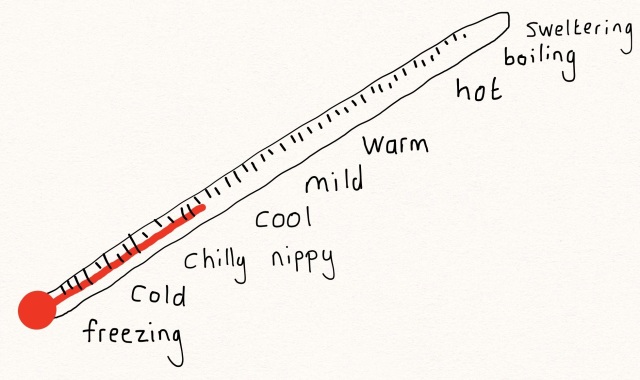
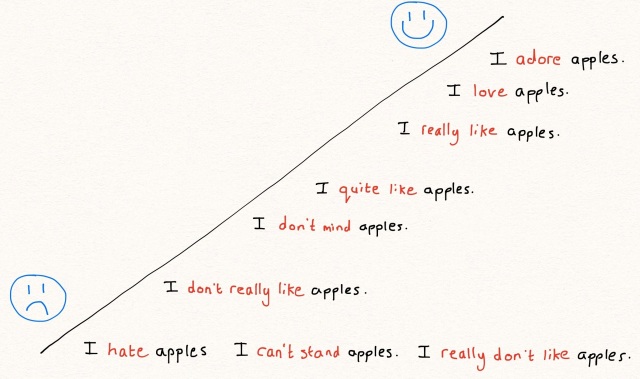
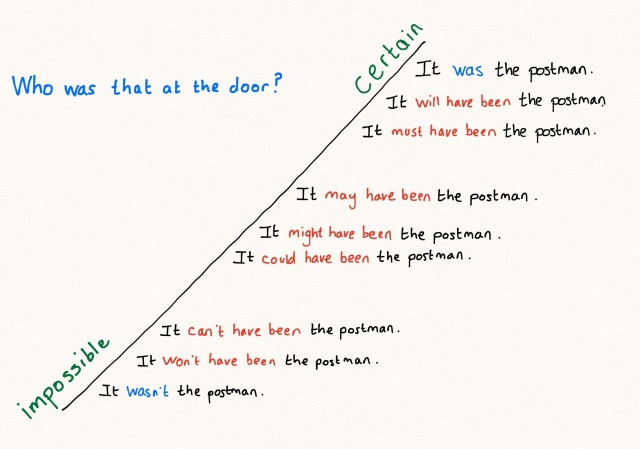
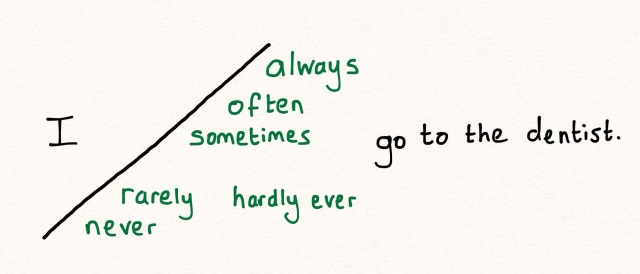
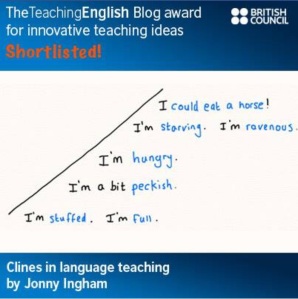







This is amazing. Thank you for such a detailed illustrations.
LikeLike
Thank you Kruti!
LikeLike
Really, logically speaking, “It was the postman.” and “It wasn’t the postman.” have the same amount of certainty (100%). The 0% end should be “I have no idea”, perhaps amplified with “absolutely”.
LikeLike
Good point Sari, see Natália’s comments below for some discussion on this.
LikeLike
I love it, and I really can see the use in my classes. Thanks a lot !
LikeLike
Thanks Casse-bonbec!
LikeLike
Very usefull thank you
LikeLike
Thank you Maha!
LikeLike
Love it!
LikeLike
Cheers!
LikeLike
what’s skuffed? and what about really WAS the mailman?
LikeLike
It’s stuffed, not skuffed! (when you are really full and have eaten too much). ‘It was the postman’ is on the cline, at the top, next to 100% certainty.
LikeLike
Thanks! I liked.
LikeLike
Thanks Janne!
LikeLike
Pingback: Clines in language teaching | Learning related ...
OMG thts my goodness to like ur page
this post is amazing
LikeLike
Thank you Ankit!
LikeLike
Amazing
İ love it
LikeLike
Pingback: Clines in language teaching | TeachingEnglish |...
Really nice board work and expressions. Googlefight or BNC ‘I always go to the dentist’ and ‘I never go to the dentist’ to see which expression is more popular.
LikeLike
Tahnks Ratgaj.
What is Gooflefight and BNC?
LikeLike
This is amazing. Thank you for such good ideas.
LikeLike
Thanks Mitu!
LikeLike
thanks very much
LikeLike
Thanks for the comment!
LikeLike
thanks I love it
LikeLike
Thank you!
LikeLike
This is super! Very useful. Thanks Jon
LikeLike
Thanks Aris!
LikeLike
It’s realy amazing, and great effort. Thank you
LikeLike
Thank you Enas!
LikeLike
And where is the verb “to dislike”??? You mention “to hate”, “not to like”… but the easy alternative, where is it?
LikeLike
You can add it. I think so. Thanks for your idea, though I think it is a wonderful work.
LikeLike
Thanks for the comment Mo. I agree, you could add many more verbs such as ‘dislike’, ‘detest’, ‘loathe’, ‘am crazy about’ etc. This would of course depend on level, board space, and how complex you want it to become. I’m not so sure about ‘dislike’ though; it feels like rather unnatural usage in this context, in my mind anyway.
LikeLike
this is simply amazing! thank you VERY much 😀
LikeLike
Thank you Paula!
LikeLike
Where I live in the US, our local paint stores have paint color samples printed on rectangular strips of heavy paper. Visualizing the clines by writing the words in order, each word on a separate color sample, already printed in light to dark order on the sample sheet, works perfectly. And the stores don’t mind you taking a batch of these color samples for free!
LikeLike
Nice idea Billhollaway, I’ll have to get to my nearest DIY shop!
LikeLike
Where is the ‘would have been’ situated on the cline of certainty?
LikeLike
Hi Ven,
I haven’t added ‘would have been’ to the cline as it doesn’t express a degree of certainty.
Whilst ‘would have been’ has the same form as these past modals of deduction, the meaning is very different; it expresses a hypothetical sitaution in the past, not certainty.
LikeLike
That’s great! Thank you for sharing. =D
I’d suggest changing the certainty cline, however. When I say “It wasn’t the postman”, I’m not 0% certain. Just the opposite, I’m 100%. When it comes to the difference between “It was”, “It must have been” and “It might have been, ok, it’s the certainty that varies, exactly like you put it. But when I say “It was” or “It wasn’t”, I’m just as certain.
LikeLike
Thanks for your comment Natália. I agree.
‘It wasn’t the postman’ isn’t 0% certainty but 100% certainty as you say.
I’ve never known how to visualise this on the cline however, and usually just explain this to the students. Any ideas anyone?
LikeLike
=) You can keep the cline exactly like it is and only show affirmative sentences. Then you can add the negative versions on another parallel cline or on the same cline to the left/right.
So
It was the postman – 100% – It wasn’t the postman
It must have been the postman – 90% – It can’t have been the postman.
It may have been the postman – 60% – It may not have been the postman.
It might have been the postman – 50% – It might not have been the postman.
[Of course the percentages are just a rough guide. I can’t draw a cline here. 😉 ]
That has the added advantage of making it crystal clear that the negative of “must” is not “mustn’t” in such cases.
LikeLike
That could work, a double cline… maybe that’s a future blog post! Thanks Natália!
LikeLike
I was thinking about this and it might work by simply changing the label on the cline. The cline could go from ‘impossible’ at the bottom, to ‘certain’ at the top. What do you think?
LikeLike
Cline updated!
LikeLike
Nice to read and incorporate
LikeLike
Simple, and brilliant!
LikeLike
Thanks very much!
LikeLike
very useful….thank u very much.
LikeLike
It was really useful
It was quite useful
It was pretty useful
It was useful
It was cool
LikeLike
A useful cline Ali!
LikeLike
Could you explain me the difference between, really don’t like and don’t really like.Thank you!!
LikeLike
Good question Suhani.
This has been answered here http://forum.wordreference.com/showthread.php?t=1469460
LikeLike
Perfect work:)) Thank You:))
LikeLike
Thanks, it’s great!
LikeLike
Reblogged this on A 2 and commented:
Amazing Post!
LikeLike
I like it, I like it a lot, I love it!
LikeLike
Cheers Jenny!
LikeLike
Pingback: Clines in language teaching | Professional Deve...
Pingback: Clines in language teaching | Purposeful Pedago...
Thanks for your post, it helped me a lot. Because I’m just a student who always follows to what method suitable to me. And I wonder if you could give me some hint of how to gather the words in group (describe the same meaning with difference of certainty or shades).
LikeLike
Pingback: Teaching Recipes | Veien mot lektor er digital
It is very helpful especially to teach english as second language here in Malaysia. Tqvm.
LikeLike
Hi Jonny,
Just to let you know that we’ve shortlisted this blog post for this month’s TeachingEnglish blog award and I’ll be making a post about it on today’s TeachingEnglish Facebook page http://www.facebook.com/TeachingEnglish.BritishCouncil, if you’d like to check there for likes and comments.
Best,
Ann
LikeLike
Thank you Ann and thanks to everyone at Teaching English for your support.
LikeLike
Great! I like using clines for degrees as you say, though I tend to tell my students it is specific and more general. If something is small I could be talking about the size of my car, the size of city, or the size of a cat. If I say something is microscopic…I have a much more specific idea of what I am talking about! http://eslcarissa.blogspot.com/2014/03/get-students-using-different-words.html
LikeLike
Shouldn’t ‘I like’ be there between ‘I don’t mind’ and ‘I quite like’?
LikeLike
Yes Luay, you could put ‘I like’ there. I imagine most students are pretty familiar with this verb though!
LikeLike
I’m going to add this to the English Teacher’s workshop program used here in S. Korea. (properly attributed, of course). You truly have created a lovely visual to help my Korean teachers of English expand both their ability to use English conversationally and convey meaning to their students. Many thanks!
LikeLike
Thank you for your comments JD Gold. Good luck with the workshop programme.
LikeLike
thank you ! the egs were very valuable, practical and constructive!! wow!! so easy for anyone to use. my students enjoyed using them…. very practical!
LikeLike
Pingback: Come Cline with Me! | Recipes for the EFL classroom
Thank you,very useful
LikeLike
Pingback: How do you feel? | Our Journey
Pingback: Useful links for CELTA | Sandy Millin
Thanks for posting these! Sharing on my Facebook page facebook.com/speakenglishlive !
LikeLike
Very nice, I will definately use this in class. One question, though… “I’m a bit peckish”. Is there a replacement for this? I try not to teach expressions that are exclusively brittish to my intermediate students.
Thanks for sharing this.
LikeLike
Thank you so much. This explanation was summarized and could understand what I wanted.
LikeLike